The national flock in France is about 10.5 million sheep, half of which are adult breeders and half of which are lambs for slaughter. Most sheep production is for meat, but there are 1.7 million dairy sheep in France.
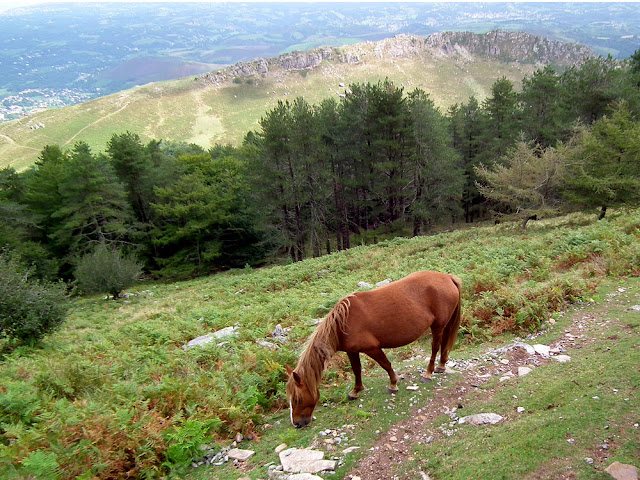 |
| A Pottock (Pyrenean mountain pony) in the Pyrénées-Atlantique, probably occasional wolf prey. |
Globally the Grey Wolf Canis lupus (Fr. loup gris) is no longer considered threatened by the IUCN and has been given 'least concern' status on the Red List since 2004. But in France it is still listed nationally as vulnerable.
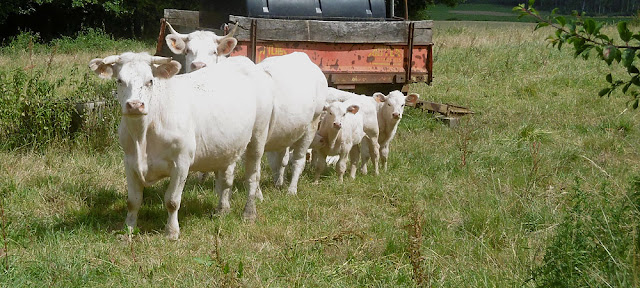 |
| I don't fancy a wolf's chances against these protective Charolais mums. |
Wolves reappeared naturally in France in 1992, coming across the Alps, after having been hunted to extinction in the 1930s. There is now estimated to be 624 individuals, and young lone wolves have been seen almost throughout the entire country, although breeding packs are still restricted to wooded mountainous areas. The species has benefitted in France from the increase in forest cover in the past fifty years, the abundance and diversity of prey (ungulates are at their highest level in half a century) and the level of legal protection wolves are afforded. Ecologists estimate that France has the capacity to support quite a few more wolves. Italy currently has at least a thousand, Spain has at least 1500, and at the end of the 18th century the wolf population of France may have been as high as 20 000 animals, with 6000 being killed on average every year.
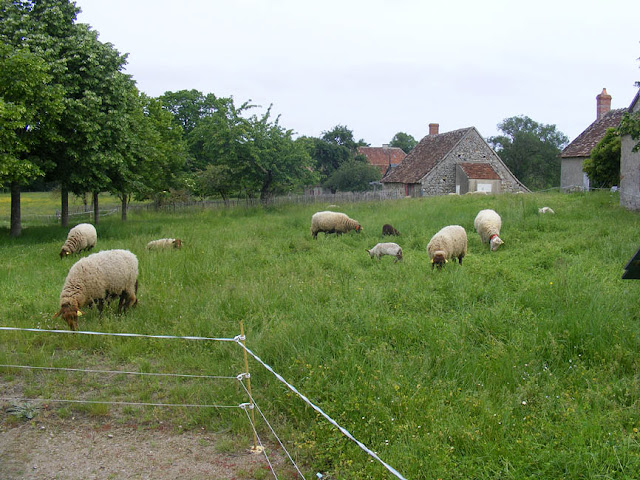 |
| A flying flock of Solognot sheep put there for conservation grazing in the Brenne wetland, Indre. |
There is no doubt that where wolf packs exist, sheep will be killed, but many people believe that attacks by stray dogs are under estimated. No official figures are kept on the number of sheep killed by stray dogs in France, but estimates from England, where the national herd is a similar size but there are no wolves, indicate that around 40 000 sheep are victim to dog attacks and die every year. In France after an attack the carcass will be examined for evidence that wolves were involved and if they were, compensation will be paid. Wolf attack seems to have a stronger psychological effect on those who have to deal with the aftermath than that of a dog attack.
 |
| A flock of sheep on the Monaro High Plain, Australia. |
Wolf attacks on livestock are increasing as the numbers of wolves increase. In 2020, 11 849 domestic ovines (sheep and goats), bovines (cattle) and equines (horses and donkeys) were officially identified as having been killed by wolves. In the same period 105 wolves were shot dead, most of them legally, but seven of them illegally and one trapped by accident. A couple more died by being hit by cars and one young female was found dead due to unknown causes.
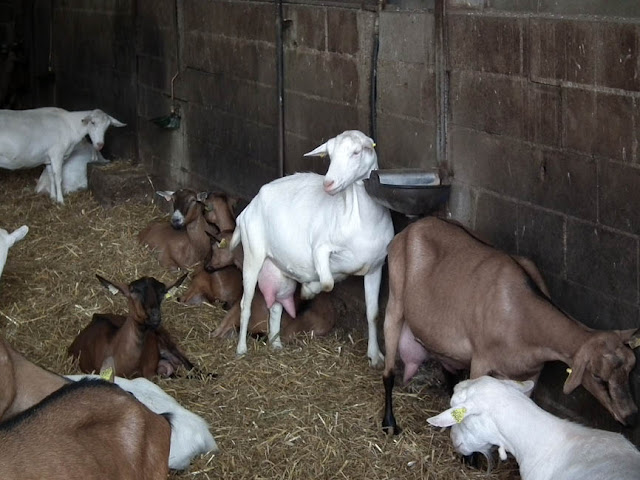 |
| Dairy goats, Indre et Loire. |
The wolf kill numbers look big and impressive in absolute terms, and they don't take into consideration all the other stress and trauma to other animals in the herd, or to the farmers, some of whom have suffered repeated wolf attacks. But in relative terms, this is about 0.1% of the national herd, and even in the hardest hit areas, only a few sheep per thousand are killed. By contrast about 400 000 sheep die each year of disease, accidents in the Alpine pastures or by being hit by lightning. Wolves do not represent an economic threat to sheep farmers, who have much more significant difficulties to overcome. And in any case half of French ewes end up being slaughtered every year, presumably because they are too old to be productive or herds are being reduced.
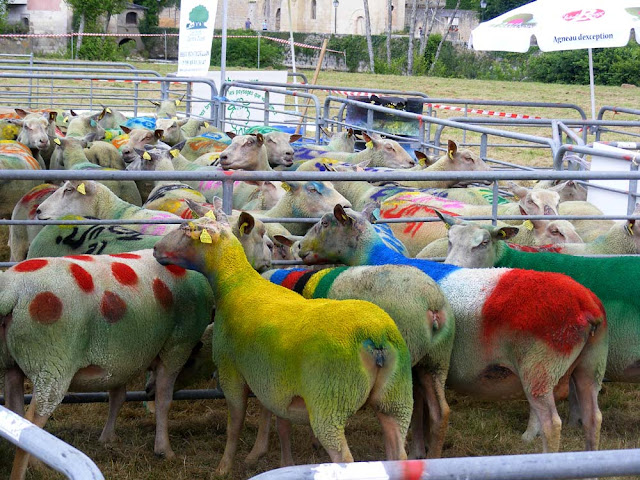 |
| Not a wolf aversion technique, but sheep painted to represent cyclists in the Tour de France, Vienne. |
Wolves are intelligent animals, but shepherds don't always take steps to protect their flocks, so either way, attacks sometimes happen. Sometimes the pastures are difficult to access or too big. Those in the hardest hit areas, about 6000 farms, can seek State aid to fund protective measures. Staff working for the aid agency acknowledge that co-habiting with wolves is difficult these days, as the knowledge of how to do so has been lost, and shepherds protect their flocks less than in the past.
 |
| Griffon Vulture, Pyrénées-Atlantique. |
The most popular method of protection for flocks today is to put special livestock guarding dogs in with them. In France these are a breed known officially as Pyrenean Mountain dogs, but usually referred to locally as 'patous'. These work well so long as the dogs are raised with the herd from puppyhood and are well trained.
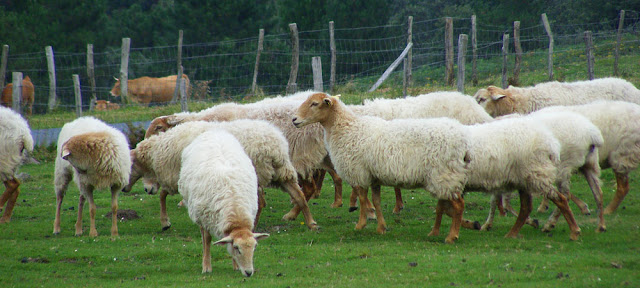 |
| Manech Tête Rousse sheep in the Pyrénées-Atlantique. |
In Romania, Spain and Italy, all with much higher wolf populations than France, attacks by wolves on livestock are much rarer. There is some conflict in areas that wolves are newly colonising in these countries, but mostly, shepherds have always had to deal with wolves and do so as a matter of course. All these countries, including France, allow for 10% of the wolf population to be legally killed each year, following a case by case process for selecting problem wolves as targets. However, the upper limits on numbers killed are rarely reached and it is not always the target wolf that is killed in the end, so this is seen as a very inadequate solution.
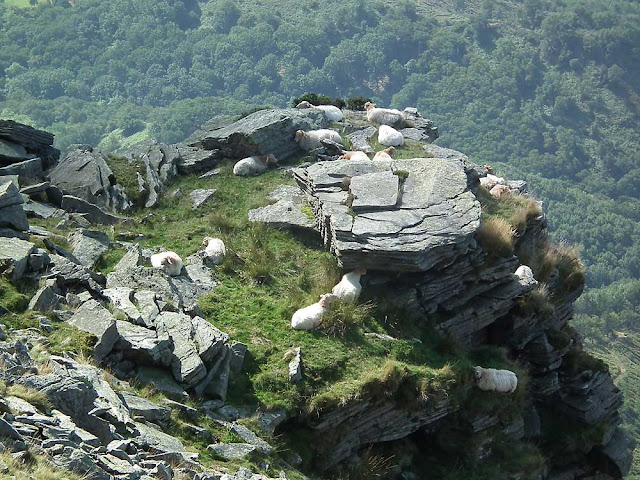 |
| Manech Tête Rousse sheep in the Pyrénées-Atlantique. |
Sheep production in France has been declining for the past 20 years. This is due to a loss of competitiveness in the French sector, in a market dominated by Australia and New Zealand. The French sector suffers from low birth numbers and high lamb mortality, the high cost of feed grain, and general lack of organisation within the industry. Sheep farmers have the lowest average income of any livestock producers and 50% of lamb meat consumed in France comes from imports. Wolf attacks are the least of their worries in terms of economic viability and competitiveness in the market.
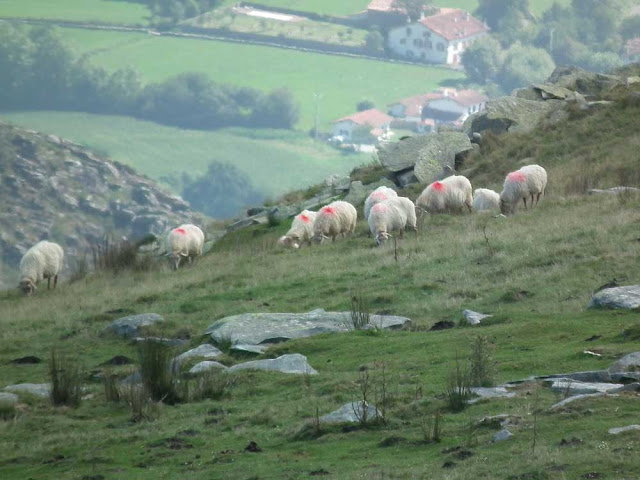 |
| Manech Tête Rousse in the Pyrénées-Atlantique. |
Both sheep and wolves are necessary to maintain the alpine pastural ecosystems. Ecologists estimate that if sheep disappear off the mountainsides, then within a decade, three to four hundred wild plant and animal species will also have disappeared. Sheep modify the landscape, preventing scrub from taking over, limiting forest fires and helping to prevent landslides. Wolves are considered to be ecological regulators. By attacking sick or weak animals they contribute to the health of the herd and can prevent outbreaks of disease. They also control the numbers of young wild boar and deer, which can threaten the forests if their numbers are not culled or they feel safe to stay in one place too long and over graze an area. The carcasses of wolf kills are a key component of rebuilding and maintaining vulture populations too. Studies of scats and carcasses show that almost all of a wolf's diet is ungulates (mostly roe deer, but also chamois, red deer and wild boar) in France, supplemented by small mammals such as hares and in some cases by domestic ungulates.
 |
| Grey Wolves in the captive breeding programme at Haute Touche Zoo, Indre. |
Wolves have proved expensive for the State to protect. Over 30 million euros was spent in 2020 on compensation for kills, and grant aid for protection measures such as enclosures and guard dogs.
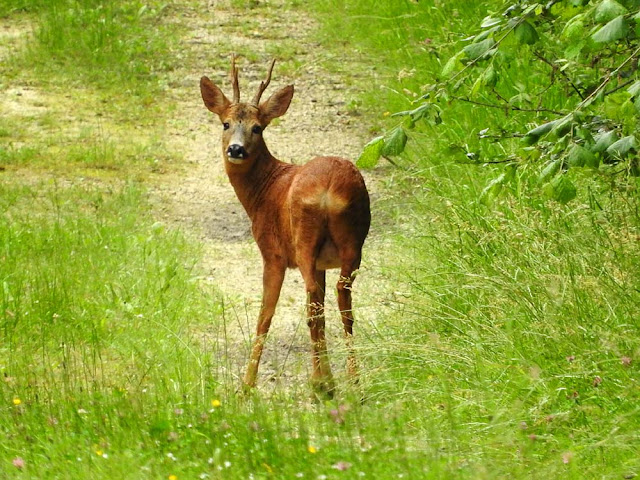 |
| Roe Deer buck, Indre et Loire (photo courtesy of my sister). |
There isn't considered to be much risk to humans from wolf attack these days. It happens occasionally in India, where a wolf will take a small child who is left alone and unprotected, but in Europe wolves are mostly unseen and rarely approach human habitation. No one has been killed by a wild wolf in living memory in France, and rabies has been declared eradicated in non-flying mammals. In France since 2008 there have been five fatal attacks by dogs on humans, most of the victims being children.

5 comments:
That was interesting. Thanks for your effort.
Nature is amazing! How to keep a delicate balance between plants and animals! Thank you for this post, Susan.
This post prompted me to check on the status of grey wolves in the US. Now that they are no longer considered endangered, hunters apparently are after them with a vengence. Twenty of them were killed in Yellowstone Nat'l Park during this hunting season, a record since they were delisted. One closely monitored pack has now been eliminated according to
park officials. Wonder how long it will be before they're back on the endangered list.
Yes, Sheila. People enjoy so much killing innocent animals that are doing what Nature intended them to do. When are we going to do the same thing to unvax Covidiots who are a danger to us all?
Potty and chm: Thank you. I'm glad you found it interesting.
Sheila: Yes, hunters here are desperate to kill wolves and bears. So depressing for the scientists monitoring that pack in Yellowstone.
Post a Comment